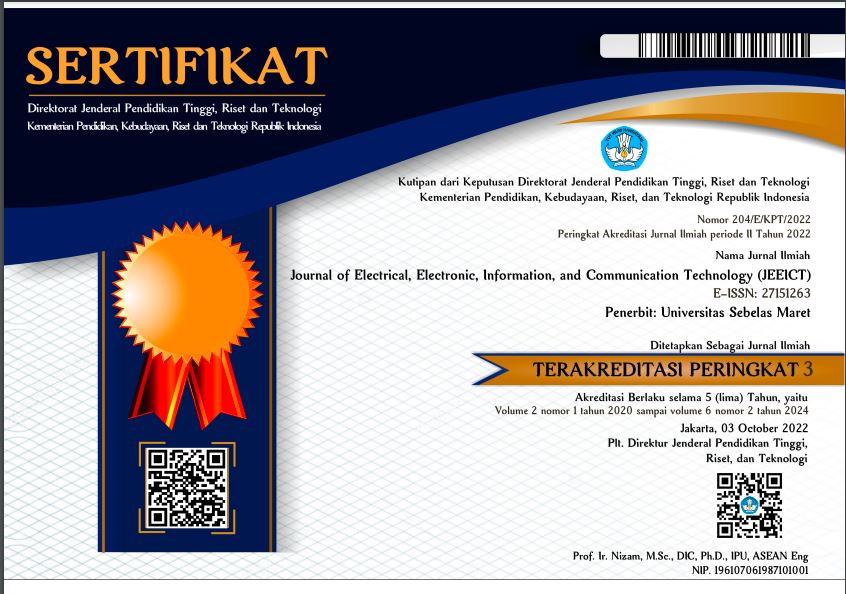Analysis of Triple Quantum Dots Single Electron Transistor (TQD-SET) for Various Configuration
Abstract
Single electron transistor (SET) has high potential for the development of quantum computing technologies in order to provide low power consumption electronics. For that purpose, many studies have been conducted to develop SET using dopants as quantum dots (QD). The working principle of SET basically is a single electron tunneling one by one through tunnel junction based on the coulomb blockade effect. This research will simulate various configurations of triple quantum dots single electron transistors (TQD-SET) using SIMON 2.0 with an experimental approach of MOSFET with dopants QD. The configurations used are series, parallel, and triangle configuration. The mutual capacitance (Cm), tunnel junctions (TJ), and temperature values of TQD-SET configurations are varied. The I-V characteristics are observed and analyzed for typical source-drain voltage (Vsd). it is found that the TQD series requires larger Vsd than parallel or triangular TQDs. On the other hands, the current in parallel TQD tends to be stable even though Cm is changed, and the current in the TQD triangle is strongly influenced by the Cm. By comparing these three configurations, it is observed that the tunnelling rate is higher for parallel TQD due to higher probability current moves through three dots by applying Vds.
Full Text:
PDFReferences
G. E. Moore, "Cramming more components onto integrated circuits," Electronics, vol. 38, no. 8, 1965.
M. M. Waldrop, "Nature International Weekly Journal of Science," Macmillan Publishers Limited, 9 February 2016. [Online]. Available: https://www.nature.com/news/the-chips-are-down-for-moore-s-law-1.19338. [Accessed 3 August 2018].
A. Rasmi and U. Hashim, "Single-Electron Transistors (SET): Literature Review," Jurnal Penyelidikan dan Pendidikan Kejuruteraan, vol. 2, 2005.
C. Wasshuber, "Computational Single-Electronic," in Computational Single-Electronic, New York, Springer-Verlag Wien, 2001.
B. Kane, "A silicon-based nuclear spin quantum computer," Nature, vol. 393, pp. 133-137, 1998.
M. Ligowski, D. Moraru, M. Anwar, T. Mizuno, R. Jablonski and M. Tabe, "Observation of individual dopants in a thin silicon layer by low temperature Kelvin probe force microscope," Appl Phys Lett, vol. 93, no. 142101, 2008.
M. Tabe, D. Moraru, M. Ligowski, M. Anwar, R. Jablonski, Y. Ono and T. Mizuno, "Single-Electron Transport through Single Dopants in a Dopant-Rich Environment," Physical Review Letters, vol. 105, no. 016803, 2010.
M. Anwar, Y. Kawai, D. Moraru, R. Nowak, R. Jablonski, T. Mizuno and M. Tabe, "Single-electron charging in phosphorus donors in silicon observed by low-temperature Kelvin probe force microscope," Japanese Journal of Applied Physics, vol. 50, no. 8S3, 2011.
M. Anwar, R. Nowak, D. Moraru, A. Udhiarto, T. Mizuno, R. Jablonski and M. Tabe, "Effect of electron injection into phosphorus donors in silicon-on-insulator channel observed by kelvin probe force microscopy," Applied Physics Letters, vol. 99, no. 213101, 2011.
K. K., "Tunneling and magnetic properties of triple quantum dots," Low Temperature Physics, vol. 33, no. 2, p. 105, 2007.
M. Y. Fathany, S. Fuada, B. L. Lawu and M. A. Sulthoni, "Modelling and simulation of parallel triangular triple quantum dots (TTQD) by using SIMON 2.0," in AIP Conference Proceedings, 2016.
T. Uchida, M. Jo, T. Fukuchi, M. Arita, A. Fujiwara and Y. Takahashi, "Evaluation of Serially Coupled Triple Quantum Dots with a Compact Device Structure by a Simultaneous Voltage-Sweeping Method," in Proceedings of the 16th International Conference on Nanotechnology, Sendai, Japan, 2016.
S. Ramadhan, A. Alfaruq, R. Pramudita and M. A. Sulthoni, "Comparison result between simulation and experiment of coupled series triple quantum dots and its characteristics with SIMON 2.0," in AIP Conference Proceedings, 2017.
Refbacks
- There are currently no refbacks.







